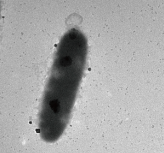Muricauda abyssi: Difference between revisions
No edit summary |
|||
| Line 28: | Line 28: | ||
==Description and Significance== | ==Description and Significance== | ||
Muricauda Abyssi is a non-motile, rod-shaped gram-negative bacterium | Muricauda Abyssi is a novel, non-motile, rod-shaped gram-negative bacterium isolated in deep seawater from the Marina Trench, the deepest point in the Earth's oceans. (NIH, 2022.) Muricauda Abyssi is important to the genus Muricauda by identifying the highest with Muricauda oceani at 99.0% and allowing for research of relations between closely related type strains in the genus Muricauda (NIH, 2022.) Muricauda abyssi are also important for modulating the process of photosynthesis. (NIH, 2018). | ||
==Genome Structure== | ==Genome Structure== | ||
Muricauda abyssi is designated as strain W52T with the 16S rRNA gene sequences indicating the microbes' relation to the members of the genus Muricauda with the major respiratory quinone being MK-6 demonstrating a biomarker for the bacterial community Muricauda abyssi resides in (NIH, 2022.) | Muricauda abyssi is designated as strain W52T with the 16S rRNA gene sequences indicating the microbes' relation to the members of the genus Muricauda with the major respiratory quinone being MK-6 demonstrating a biomarker for the bacterial community Muricauda abyssi resides in (NIH, 2022.) The polar lipids in Muricauda abyssi are phosphatidylethanolamine (PE) and there were three unidentified lipids and one unidentified amino lipid with iso-C15 : 0, iso-C17 : 0 3-OH and iso-C15 : 1G as the major fatty acids. (NIH, 2022). The makeup of these structures allows for Muricauda abyssi to appear in yellow, circular colonies. This genome sequencing allows for surviving cold temperatures, and resisting Ultraviolet Radiation. | ||
==Cell Structure, Metabolism and Life Cycle== | ==Cell Structure, Metabolism and Life Cycle== | ||
Revision as of 23:59, 16 November 2023
Classification
Bacteria; Bacteroidota; Flavobacteriia; Flavobacteriales; Flavobacteriaceae; Muricauda
Species
Muricauda abyssi
Genus Muricauda
|
NCBI: [1] |
Description and Significance
Muricauda Abyssi is a novel, non-motile, rod-shaped gram-negative bacterium isolated in deep seawater from the Marina Trench, the deepest point in the Earth's oceans. (NIH, 2022.) Muricauda Abyssi is important to the genus Muricauda by identifying the highest with Muricauda oceani at 99.0% and allowing for research of relations between closely related type strains in the genus Muricauda (NIH, 2022.) Muricauda abyssi are also important for modulating the process of photosynthesis. (NIH, 2018).
Genome Structure
Muricauda abyssi is designated as strain W52T with the 16S rRNA gene sequences indicating the microbes' relation to the members of the genus Muricauda with the major respiratory quinone being MK-6 demonstrating a biomarker for the bacterial community Muricauda abyssi resides in (NIH, 2022.) The polar lipids in Muricauda abyssi are phosphatidylethanolamine (PE) and there were three unidentified lipids and one unidentified amino lipid with iso-C15 : 0, iso-C17 : 0 3-OH and iso-C15 : 1G as the major fatty acids. (NIH, 2022). The makeup of these structures allows for Muricauda abyssi to appear in yellow, circular colonies. This genome sequencing allows for surviving cold temperatures, and resisting Ultraviolet Radiation.
Cell Structure, Metabolism and Life Cycle
Muricauda abyssi are small gram-negative, rod-shaped bacteria that form microscopic yellow colonies and synthesize zeaxanthin, which is a Zanthophyll that modulates the process of photosynthesis if a plant is overexposed to sunlight (NIH, 2018).
Ecology and Pathogenesis
Muricauda abyssi is a marine bacterium found in the deep seawater of the Marina Trench. All members of the Muricauda genus were originally isolated from salty environments including marine snow, hot springs, clouded seawater etc. Muricauda abyssi help to synthesize zeaxanthin which protects nature and plants during photosynthesis from excessive sunlight (NIH, 2018).
References
Wang D, Wu Y, Liu Y, Liu B, Gao Y, Yang Y, Zhang Y, Liu C, Huo Y, Tang A, Xu Y, Wei Y. Muricauda abyssi sp. nov., a marine bacterium isolated from deep seawater of the Mariana Trench. Int J Syst Evol Microbiol. 2022 Dec;72(12). doi: 10.1099/ijsem.0.005615. PMID: 36748599.
Dong B, Zhu S, Chen T, Ren N, Chen X, Chen Y, Xue Z, Shen X, Huang Y, Yang J, Chen J. Muricauda oceani sp. nov., isolated from the East Pacific Ocean. Int J Syst Evol Microbiol. 2020 Jun;70(6):3839-3844. doi: 10.1099/ijsem.0.004241. PMID: 32496184.
Zheng, Y., & Sun, C. (2019). Draft Genome Sequences of Two Bacterial Strains, Muricauda sp. 72 and NH166, Isolated from the South China Sea and West Pacific Ocean. Microbiology resource announcements, 8(44), e01042-19. https://doi.org/10.1128/MRA.01042-19
Murillo, A. G., Hu, S., & Fernandez, M. L. (2019). Zeaxanthin: Metabolism, Properties, and Antioxidant Protection of Eyes, Heart, Liver, and Skin. Antioxidants (Basel, Switzerland), 8(9), 390. https://doi.org/10.3390/antiox8090390
Vizzotto, C. S., Lopes, F. A. C., Green, S. J., Steindorff, A. S., Walter, J. M., Thompson, F. L., & Krüger, R. H. (2018). Draft Genome Sequence of Muricauda sp. Strain K001 Isolated from a Marine Cyanobacterial Culture. Genome announcements, 6(22), e00451-18. https://doi.org/10.1128/genomeA.00451-18
Author
Page authored by Trinity Butler, student of Prof. Bradley Tolar at UNC Wilmington.

